Why Wichita’s Century II is salvaged but not quite saved
Wichita’s Century II convention center and a historic library remain intact. But the story of their survival is unfinished, and it leaves lingering questions about the community and how it will make decisions about the future of its riverfront.
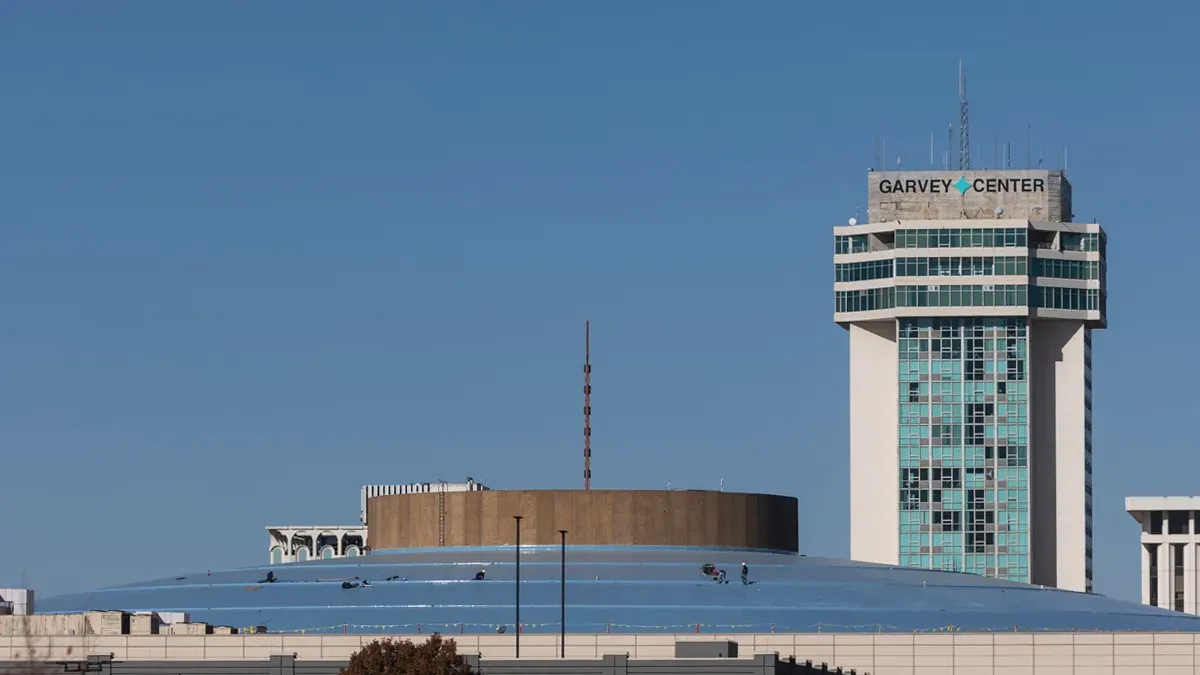
Even as workers finished replacing the distinctive blue roof of Century II, the flying saucer of a convention center that landed in downtown Wichita in 1969, the fate of the landmark and the area surrounding it remains strangely murky.
After a master plan that pushed to replace it, a grassroots campaign to save it, and political and legal fights that amounted to a battle for the future of Wichita – and the past’s place in it – five long years of discussion haven’t brought much clarity.
For now, Century II has avoided the fate of its predecessor, the Forum.
But its endurance seems less a victory than a stalemate, based on interviews with community members and architecture experts.
The story of Century II’s dramatic arc raises questions about how Wichita and other midsize cities can better build consensus and chart a course for redevelopment of public lands.
Whose voices are left out or sidelined in planning processes? Or to put it another way: Why did divisions emerge during the master-planning process? Is it possible to engage a true cross section of a city’s population and not just elevate the loudest voices? And what role does Wichita’s history play in its future?
A victory for preservationists
Century II’s story begins on May 23, 1961, when Wichita voters approved the construction of a new civic center near the banks of the Arkansas River. The complex, including a performing arts venue and a new public library, would replace the Forum, opened in 1911.
Designed by two local up-and-coming architecture firms, the civic center created instant landmarks. John Hickman and partner Roy Varenhorst had apprenticed with Frank Lloyd Wright and brought his aesthetic to the performing arts center, which was full of allusions to the Kansas landscape: buff-colored concrete to suggest billowing fields of wheat, a dome the color of the expansive sky. The public library, by Schaefer Schirmer & Eflin Architects, featured a delicate, exposed concrete skeleton and soaring walls of glass. Signaling the importance of the library, following its completion the firm flew Julius Shulman, a highly regarded photographer of modern architecture, from Los Angeles to Wichita to photograph the building.
Our free email newsletter is like having a friend who always knows what's happening
Get the scoop on Wichita’s arts & culture scene: events, news, artist opportunities, and more. Free, weekly & worth your while.
No spam. Unsubscribe anytime.
Over time, the buildings aged, racking up ever-longer lists of maintenance needs. In 2018, the city opened a new downtown library, leaving the former library building vacant.
In 2020, the Riverfront Legacy Master Plan Coalition, an organization made up of the Greater Wichita Partnership, Visit Wichita, the Wichita Chamber of Commerce and other groups, along with a consultant team made up of Populous, OLIN, and RCLCO Real Estate Advisors, unveiled a 10-year vision for a 70-acre section of the Wichita riverfront that included the civic center site. In the plan, Century II, the adjacent expo hall and park, and the former library would be demolished and replaced with dense commercial, retail and residential developments, interspersed with a new performing arts center, a riverfront park and a pedestrian bridge spanning the river.
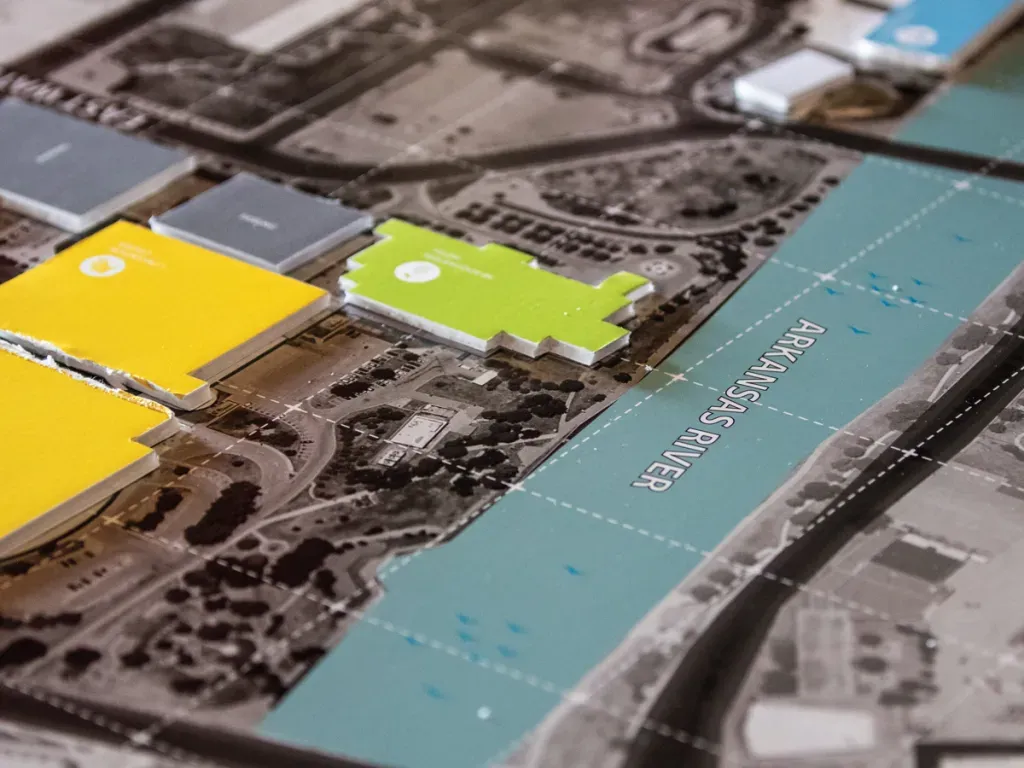
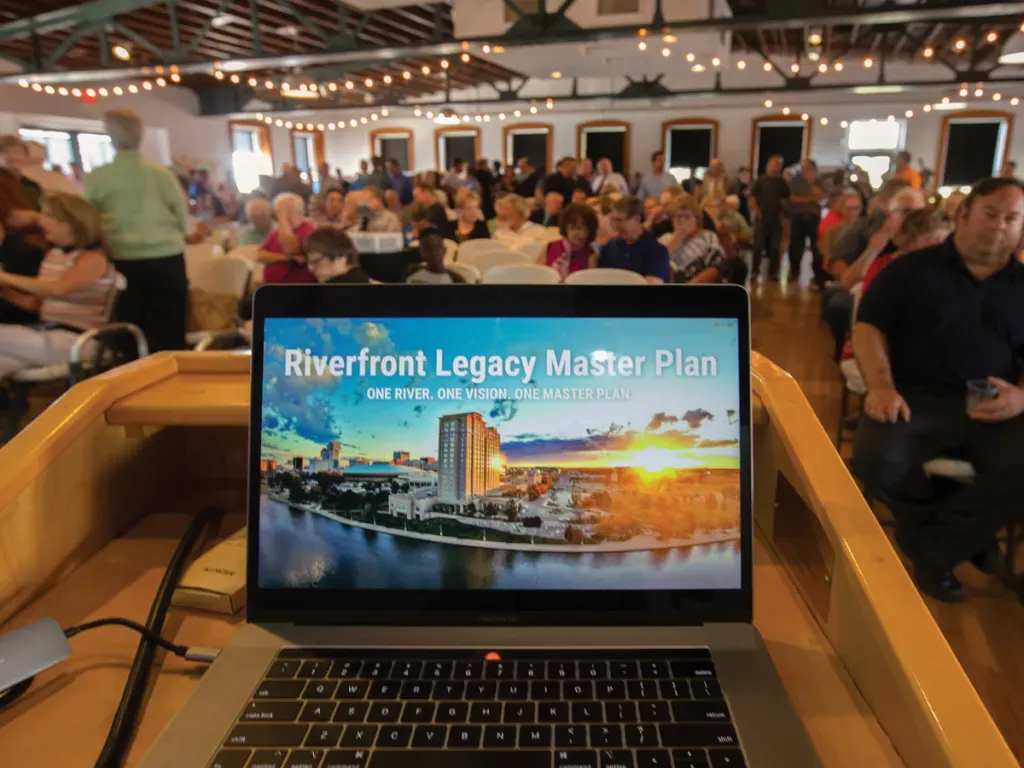
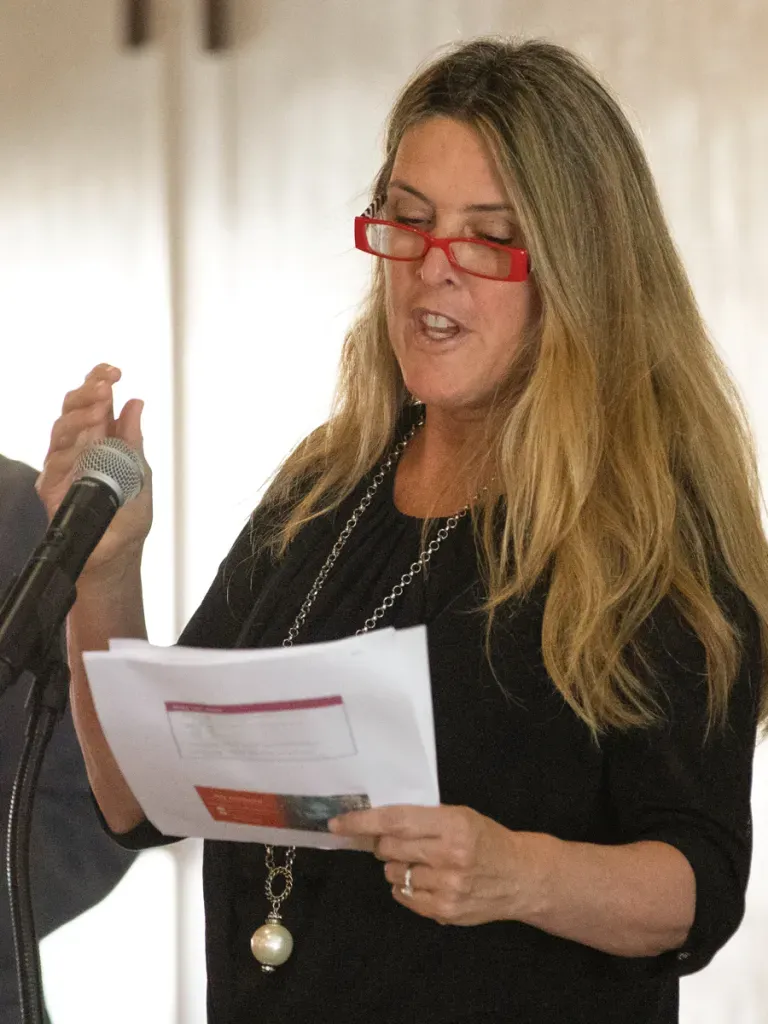
Four years ago, the Riverfront Legacy Master Plan was unveiled to residents with considerable fanfare, scale models and presentations. Susie Santo, president and CEO of Visit Wichita, was an enthusiastic supporter. Photos by Jeff Tuttle for the KLC Journal.
The recommendation that Century II and the library be torn down sparked outrage. While some argued that Century II had become just as antiquated as the Forum, others – in particular a group calling itself Save Century II – argued the buildings should be renovated.
The pressure worked. Three years later a new plan, also developed by Populous, was presented to city leaders. Encompassing a fraction of the original 70 acres, the plan includes only a new convention center and pedestrian bridge. Century II and the library would remain. Combined with both buildings’ listings on the National Register of Historic Places in 2020, the reversal was a clear, but perhaps not permanent, victory for the preservationists.
A black hole’s shadow
The Riverfront Legacy Master Plan started in response to a historic shift in downtown Wichita.
“We started with about 1,300 residential units in our downtown,” says Jeff Fluhr, the president of the Greater Wichita Partnership, a regional economic development organization. “Now, our market demand is getting up to 4,300 new units.”
From the coalition’s perspective, a lot of land along the east bank of the river was underutilized. The civic center had replaced dense commercial blocks with monumental buildings set amid vast, open plazas and parking lots. Like other projects of the time, the project was partially funded through Wichita’s Urban Renewal Agency. More than 120 businesses – from service stations to cafes, many of them serving blue-collar workers – were displaced. Buildings were demolished and forgotten.
The construction of the civic center refashioned a person’s experience of downtown Wichita in ways that are still felt today. Lucinda Sanders is the CEO of OLIN, the Philadelphia-based landscape architecture firm hired to develop the first riverfront plan with Populous. She recalls her first visit to the site in 2019.
“There was nothing pleasant about being around Century II, as a person of the public not going to an event there,” Sanders says. The scale of the building and its neighboring plaza, she says, “had this deadening effect.”
The civic center sits on a stereotypical midcentury “superblock,” a mega-sized parcel of land that doesn’t conform to the city’s street grid and largely separates downtown from the river. With a footprint larger than three football fields and a circular shape, Century II became like a planet with its own gravitational force. Except, to some, the building is more like a black hole. “(Activity) tends to be very pulsating and event-driven,” Sanders explains.
Inspired by an unrealized 1922 plan that would have preserved the Forum, Sanders and the master plan team sought to break up the superblock, reinsert the city street grid and create accessible connections to the riverfront. “If you want to get people to the water, you have to give them pleasant ways to get there,” Sanders says, not make it feel like a demilitarized zone.
From the earliest public meetings, things began to go sideways. On July 31, 2019, Celeste Racette, a former bank auditor and fraud investigator for the Federal Deposit Insurance Corp., showed up to the Wichita Boathouse with a folder of historic photographs and other artifacts from the planning of Century II that she had uncovered following her father’s death in 2012.
Racette’s father, Vincent Bogart, oversaw the development of the civic center as the city’s mayor during a particularly turbulent period. Her father’s connection to Century II made it something of a family legacy for Racette.
At the open house, she asked, “Are we going to ask questions about Century II?” she recalls. “And they said, ‘No, we’re going to make a presentation.’ So I went downstairs and sat at an empty table, and put this neat brochure and some other stuff from my dad’s collection on the table.”
Racette says she had hoped that attendees would learn more about Century II’s history. But “all of a sudden, this lady came up,” Racette says. “She pointed her finger at me and she said, ‘You have to leave.’ I was stunned. I said, ‘What am I doing?’ She said, ‘You’re hijacking our meeting.’ I said, ‘Isn’t this a public meeting?’ She said, ‘No, we’ve paid for it, and you have to leave.’”
Tami Bradley, the woman in question, recalls the incident differently. Bradley served on the public relations team for the Riverfront Legacy Master Plan. She says that the first public engagement meeting was designed to provide the public with an overview of the master-planning process, with various informational tables arranged throughout the second floor of the boathouse. Bradley says Racette requested permission to set up a table and present the materials she had brought. “When she was told she could not, she set up her materials at the front door, where we were checking in people, which was disruptive and confusing,” Bradley wrote in an email. “I asked Ms. Racette to please not set up her materials in the check-in area, and when she refused, I did ask her to leave.”
Racette packed up her things. That same night, she says she drove to Denver to be with her son and daughter-in-law following her granddaughter’s birth. When she returned a week later, she says she had multiple voice messages from people who had been at the meeting or had read about her expulsion in The Wichita Eagle.
“People got upset and started reaching out to me,” Racette says. One of those people was Greg Kite, the president of the Historic Preservation Alliance of Wichita. “He wanted to help. And that’s all it takes,” Racette says. “It takes two people.”
Demanding public input on civic buildings
Racette and Kite launched Save Century II to advocate for preserving Century II and the library. They rented office space and began circulating a petition for a municipal ordinance to require a public vote on plans to demolish historically or architecturally significant buildings. “We started the petition drive during COVID,” Racette recalls. “People would drive up – they’d have masks on – and we’d run out with the petition. We got 17,265 signatures for a municipal initiative petition during COVID.”
Two ideas formed the campaign’s core.
The first was that Century II was part of the city’s identity. Together with the library, the nearby 1920 Carnegie Library and the 1890 Sedgwick County Courthouse (now the Sedgwick County Historical Museum), a single downtown block represented 100 years of Wichita history. “You look at old telephone books, and it’s the dome of Century II (on the cover),” says Robert McLaughlin, the founder of KC Modern, a nonprofit organization that advocates for the preservation of modern architecture in Kansas. “(Wichitans) were very proud of that building for a long time.”
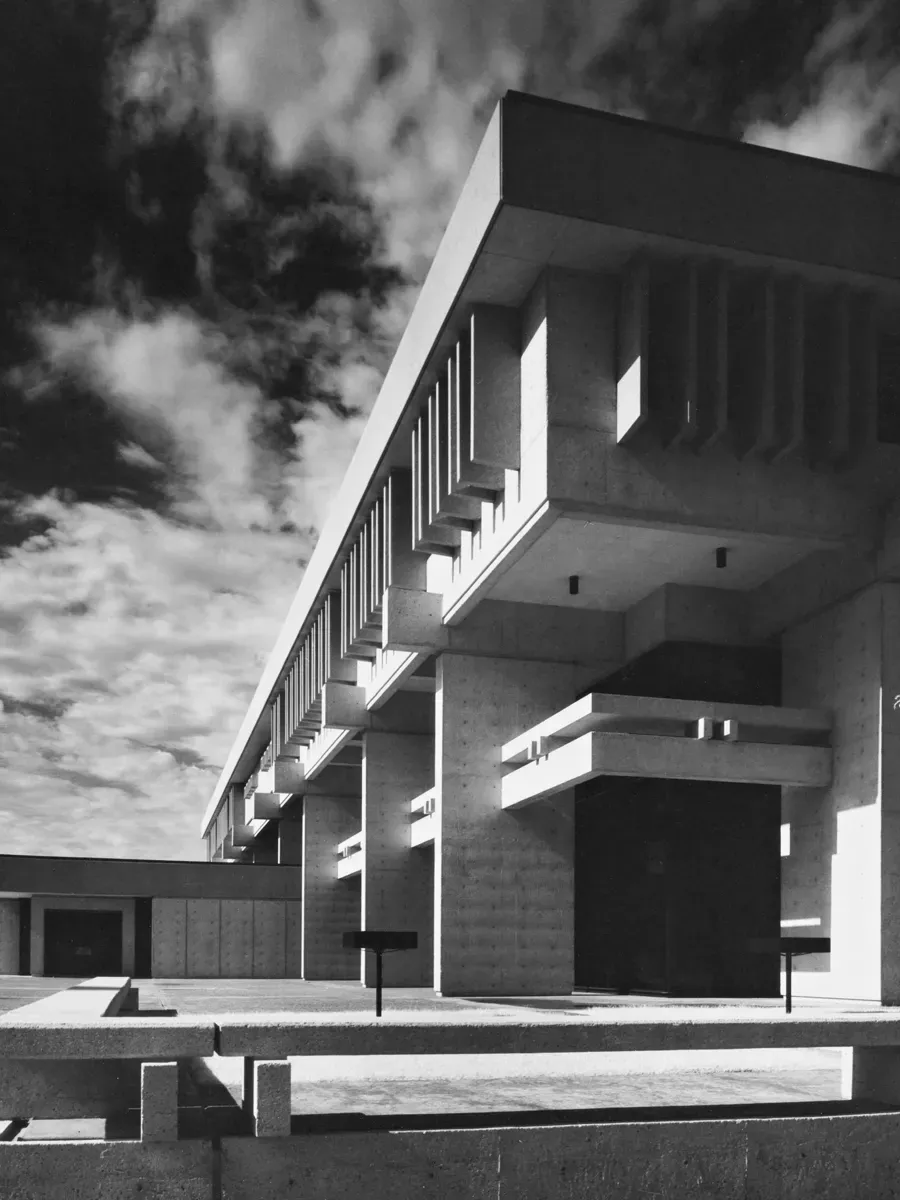
The second idea was that the public should influence what happens to civic buildings on city-owned property. Racette wanted to see proposals such as those recommended by the Riverfront Legacy Master Plan go before the voters, just as the 1961 civic center project had.
Racette also desired a larger political transformation. In recent developments, she had seen a pattern of private interests extracting value from publicly owned assets without providing equitable returns to the community. “City hall is so one-sided toward private interests,” Racette says. “To turn everything over to private developers runs totally contrary (to) that sense of keeping (the riverfront) available for public enjoyment.”
Indeed, a big piece of the Riverfront Legacy Master Plan would have made way for new private residential and commercial development. It was the economic engine that purportedly would pay for the performing arts center. But the furor over Century II’s historic significance mostly obscured Racette’s second point.
“The fight became about historic preservation, and what was lost was the privatization of what was mostly public land,” says Chase Billingham, an associate professor of sociology at Wichita State University.
Billingham studies how cities and neighborhoods change over time and has written about Wichita’s urban renewal era.
He sees in the Riverfront Legacy Master Plan something of the inverse of urban renewal. For all of its flaws, urban renewal “was about bringing to bear the resources of the federal government and public tax dollars to support the rejuvenation of cities, oftentimes with a very civic-minded focus,” he says. Century II and the library are reminders “that the public sector is necessary in a time of urban crisis.”
Of course, not everyone agrees that Century II is worth saving. Some Wichitans view an attachment to Century II as a nostalgic pining for the past or as a hindrance to the city’s growth.
Amber Luther, a planner in Populous’ San Francisco office, led the community engagement portion of the Riverfront Legacy Master Plan. She says the community was split nearly 50-50 on Century II. “There was such a tight percentage of people who were for complete change and people who wanted to keep it as it was, that we came to (the client) and said, ‘Hey, we’re seeing a real close call with what people want to do here.’”
Adam Wagoner embodies this ambivalence. The co-founder of Denver’s Further Architecture Office and the host of the Architect-ing Podcast, Wagoner grew up in McPherson and opened his first architectural practice in Wichita in 2009.
Wagoner agrees that the performing arts center is an indelible and instantly recognizable feature of Wichita’s skyline. “It’s one of the better examples of Frank Lloyd Wright’s organic architecture coming to Kansas,” Wagoner says. “It’s such a striking building in its formal clarity and rigor. (It’s) like this moment of real, pure architecture.”
But Wagoner also says fixating on a building can overshadow other considerations, such as undoing urban renewal’s mistakes. “As a piece of architecture, I think fondly of Century II,” he says. “But if that’s standing too much in the way of progress and really activating this location, then I think that it should go and be replaced by something that could really be a catalyst.”
Mixed outcomes
Three weeks after Save Century II delivered its petition, the city of Wichita challenged the group in Sedgwick County District Court. The proposed ordinance was “overly broad,” the lawsuit claimed, and would create an “impractical precedent.” A judge sided with the city. Save Century II appealed.
Meanwhile, Racette worked to get Century II and the public library listed on the national, state and local registers of historic places. By the end of 2020, both buildings had been approved for listing on all three. But such designations only trigger a state review that results in a nonbinding recommendation. They don’t guarantee a building’s survival.
“It is possible to tear down a nationally registered building,” McLaughlin says, pointing to Topeka’s Docking State Office Building, a 12-story building completed in 1957 that was the subject of a similar preservation battle prior to its demolition in 2023.
Save Century II fared less well in court. In December 2022, the Kansas Court of Appeals upheld the district court’s decision. Nonetheless, Wichita city officials sensed a shift in public opinion and promised to not tear down Century II without a vote.
Mayor Lily Wu says she too supports the holding of a public vote prior to any demolition plans: “Whatever happens with Century II should be transparent, fiscally responsible, (and) have community buy-in,” she says.
What about the library?
In the riverfront debate, Century II overshadowed many things, including both literally and figuratively, the library. While Save Century II fought for preserving both buildings, its own name helped center the debate on the performing arts center. And yet many architects argue that the former library, which won a national award from the American Institute of Architects in 1968, is the more elegant building.
“If you said the library is probably about the best building in Wichita, I think you’d be right on track,” says McLaughlin of KC Modern.
Abdallah Tabet, a landscape architect at OLIN, says the library lacks some of the liabilities of Century II and its smaller footprint makes it more compatible with any redevelopment that breaks up the superblock.
That gives the library a more compelling narrative for salvation. And public appreciation for it may be growing, due to Save Century II’s advocacy efforts and the building’s use as a pandemic vaccination center. “I think that opened a lot of people’s eyes,” McLaughlin says. “They took all of the bookshelves out, and people walked in and suddenly (said), ‘Wow, this is a pretty incredible space. Maybe we shouldn’t be tearing this thing down.’”
Unrelated factors may also have given preservationists an edge in this fight. Disruptions from the pandemic and the grounding of Boeing’s MAX 737 jet, for which a large local employer, Spirit Aerosystems, supplies assemblies, also loomed large.
“Those two events contributed to deflating the momentum behind the Riverfront Legacy Master Plan,” Billingham says. “But the third thing, which I think was equally important, is that they really just did not see Celeste Racette coming. They did not fully appreciate how committed she was to this cause and the lengths that she would go to to get in their way.”
‘You need to be willing to pay’
Along with Century II, Wichita’s future is on the line too. Underlying the debate are questions about what sort of city Wichita is: Is it a provincial city overly attached to the achievements of its past? Or is it a forward-looking metropolis, poised to capitalize on the promise of the future? In truth, the city is both and neither, the simplistic framing of the question misleading in its zero-sum assumptions.
The question of what a community values – and therefore what it ought to preserve – is hardly regressive. Nor is historic preservation fundamentally opposed to economic development: According to the National Trust for Historic Preservation, the federal historic tax credit program has created 2.41 million jobs since its inception and generated $1.20 in tax revenue for every $1 spent on preservation.
Broader questions about the value of civic space and who gets to plan it remain in play too. The preservationists often treated demolition as the worst-case scenario, a loss of incalculable finality. But the library already sat empty. Century II was slowly deteriorating. If this was how the city treated its civic assets – whether by choice or by financial necessity – what did that say about the community? And what guarantee do residents have that a new building won’t suffer the same fate?
Populous’ Luther says the scaled-back approach presented in January 2023 doesn’t replace the initial master plan. “I wouldn’t even call it a plan; I would call it a feasibility study,” she says. “The riverfront plan took a real estate development approach to a 70-acre site. This most recent update really just looked at the convention center itself.” She says Wichita needs a vision for the riverfront, and she wonders where it will come from.
On that point, Billingham agrees. “Regardless of what you thought of the Riverfront Legacy Master Plan, it was a cohesive plan,” he says. “The whole idea now is it’s going to be piecemeal. ‘We’re going to do it when we can, however we can find the money.’ It’s just not exciting. The plans are not inspiring.”
For Luther, the energy behind Save Century II sends a signal. If the community wants to renovate Century II and the library, “Fine,” she says, “Then city of Wichita, you need to be willing to pay for this.”
It’s happening to an extent. The city’s 2023 budget included $18 million over 10 years for upgrading Century II, including $5 million for a new (still blue) roof. And the city has asked for proposals allowing adaptive reuse of the library building, which suffers from deferred maintenance.

Decisions through democracy
“Part of community engagement is to learn what you may not know,” Fluhr says, and certainly, the discourse around Century II brought new information and attitudes. But did the most consequential issues get debated?
Yes, Century II and the library building carry historic status. But are they more appreciated as a result? Or has Save Century II only driven an existing wedge deeper? Has the fight resulted in any meaningful change in the way the community will approach large-scale master plans in the future?
When asked how much clarity the community has on its goals for the riverfront, Billingham is succinct: “Zero. None at all.”
And yet he says Save Century II’s message struck a chord with residents. City officials have taken note of the community’s interest in deciding the fate of Century II through democratic means.
“That’s a pretty good lesson to learn from Century II and the old library,” McLaughlin says. “We do have a say in our public buildings and what’s important to us.”

A version of this article appears in the Spring 2024 issue of The Journal, a publication of the Kansas Leadership Center. To learn more about KLC, visit http://kansasleadershipcenter.org. Order your copy of the magazine at the KLC Store or subscribe to the print edition.
This article first appeared on KLC Journal and is republished here under a Creative Commons license.![]()
Support Kansas arts writing
The SHOUT is a Wichita-based independent newsroom focused on artists living and working in Kansas. We're partly supported by the generosity of our readers, and every dollar we receive goes directly into the pocket of a contributing writer, editor, or photographer. Click here to support our work with a tax-deductible donation.
❋ Derby man has the kind of voice that turns heads — and chairs
❋ Socializing while sober: how some Wichitans are cultivating alcohol-free communities
❋ As a small creative business closes, the owner mourns
❋ Painting through it: Autumn Noire on 20 years of making art
❋ How a guy from Wichita resurrected 'Dawn of the Dead'
❋ Bygone Friends University museum housed curious collections



